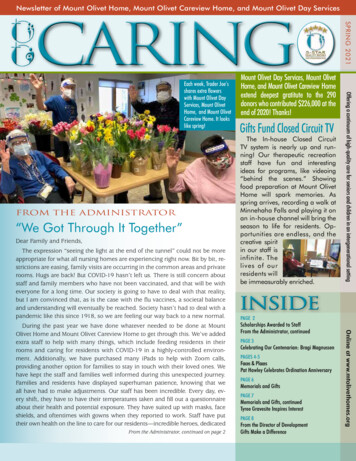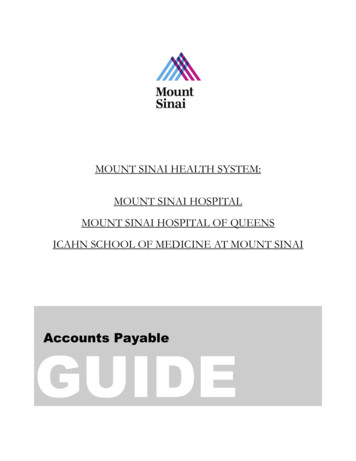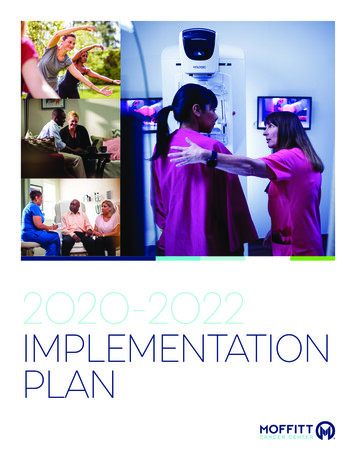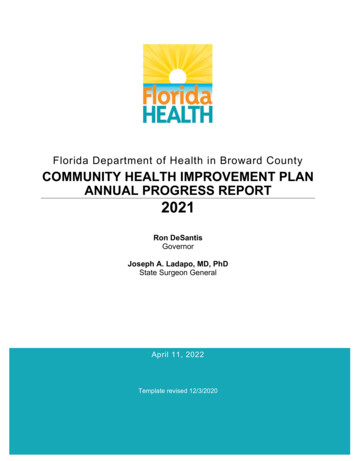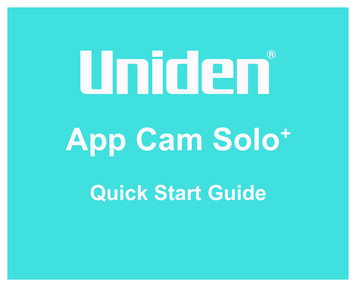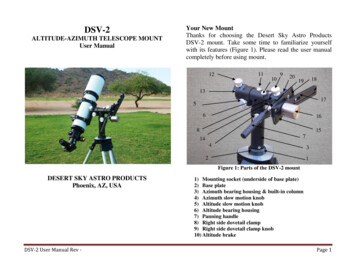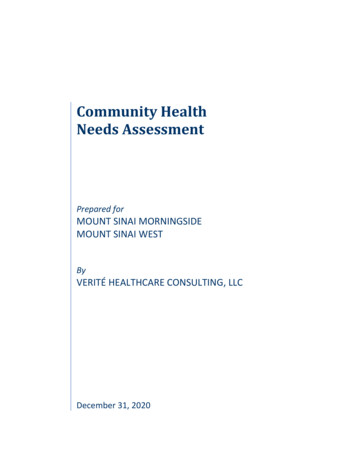
Transcription
Community HealthNeeds AssessmentPrepared forMOUNT SINAI MORNINGSIDEMOUNT SINAI WESTByVERITÉ HEALTHCARE CONSULTING, LLCDecember 31, 2020
ABOUT VERITÉ HEALTHCARE CONSULTINGVerité Healthcare Consulting, LLC (Verité) was founded in May 2006 and is located inArlington, Virginia. The firm serves clients throughout the United States as a resource that helpshealth care providers conduct Community Health Needs Assessments and developImplementation Strategies to address significant health needs. Verité has conducted more than50 needs assessments for hospitals, health systems, and community partnerships nationally since2010.The firm also helps hospitals, hospital associations, and policy makers with community benefitreporting, program infrastructure, compliance, and community benefit-related policy andguidelines development. Verité is a recognized national thought leader in community benefitand Community Health Needs Assessments.The community health needs assessment prepared for Mount Sinai Morningside & Mount SinaiWest was directed by the firm’s Vice President with a senior associate supporting the work. Thefirm’s staff hold graduate degrees in relevant fields.More information on the firm and its qualifications can be found at www.VeriteConsulting.com.Mount Sinai Morningside & Mount Sinai WestCommunity Health Needs Assessment1
TABLE OF CONTENTSABOUT VERITÉ HEALTHCARE CONSULTING .1TABLE OF CONTENTS .2EXECUTIVE SUMMARY .4INTRODUCTION .4OBJECTIVES AND METHODOLOGY .5REGULATORY REQUIREMENTS .5METHODOLOGY .6Collaborating Organizations .6Information Gaps .7Input on Previous CHNA .7PRIORITIZED SIGNIFICANT COMMUNITY HEALTH NEEDS .8Access to Mental Health Care and Poor Mental Health Status .8Access to Primary Health Care Services by Individuals with Limited Resources .9Aging Population .9Chronic Diseases and Contributing Lifestyle Factors . 10COVID-19 Pandemic and Effects . 10Environmental Determinants of Health . 11Homelessness . 11Navigating a Changing Health Care Provider Environment . 12Poverty, Financial Hardship, and Basic Needs Insecurity . 12Safe and Affordable Housing . 13Socio-Economic, Racial, Cultural, Ethnic, and Linguistic Barriers to Care . 13Substance Abuse . 14CHNA DATA AND ANALYSIS . 15DEFINITION OF COMMUNITY ASSESSED . 16SECONDARY DATA ASSESSMENT . 19DEMOGRAPHICS . 19ECONOMIC INDICATORS . 28People in Poverty . 28Household Income. 30Unemployment Rate . 32Insurance Status . 34Crime. 39Housing and Homelessness . 41State of New York and New York City Budget Trends. 43LOCAL HEALTH STATUS AND ACCESS INDICATORS . 54County Health Rankings . 54New York State Department of Health . 59Youth Risk Behavior Surveillance System . 75New York Prevention Agenda 2019-2024 . 76New York City Community Health Survey . 81AMBULATORY CARE SENSITIVE CONDITIONS . 83Borough/Neighborhood-Level Analysis . 83ACSC Conditions Analysis . 86COMMUNITY NEED INDEX , SOCIAL VULNERABILITY INDEX, 500 CITIES PROJECT, AND FOOD DESERTS . 87Dignity Health Community Need Index . 87Social Vulnerability Index . 89500 Cities Project. 94Food Deserts (Lack of Access to Nutritious and Affordable Food) . 97MEDICALLY UNDERSERVED AREAS AND POPULATIONS . 98HEALTH PROFESSIONAL SHORTAGE AREAS . 100DESCRIPTION OF OTHER FACILITIES AND RESOURCES WITHIN THE COMMUNITY . 104FINDINGS OF THE NYC HEALTH DEPARTMENT COMMUNITY HEALTH ASSESSMENT. 108Mount Sinai Morningside & Mount Sinai WestCommunity Health Needs Assessment2
CDC COVID-19 PREVALENCE AND MORTALITY FINDINGS . 109PRIMARY DATA ASSESSMENT . 111SUMMARY OF INTERVIEW FINDINGS . 111ISSUES IDENTIFIED BY INTERVIEW PARTICIPANTS . 112ORGANIZATIONS PROVIDING COMMUNITY INPUT . 115SOURCES . 116APPENDIX - ACTIONS TAKEN SINCE PREVIOUS CHNA . 119Mount Sinai Morningside & Mount Sinai WestCommunity Health Needs Assessment3
EXECUTIVE SUMMARYIntroductionThis community health needs assessment (CHNA) was conducted by Mount Sinai Morningside& Mount Sinai West (“MSM & MSW” or “the hospital”) to identify community health needsand to inform development of an implementation strategy to address identified significant needs.Mount Sinai Morningside Hospital & Mount Sinai West is comprised of two campuses, MountSinai Morningside and Mount Sinai West, both in Manhattan. To enhance clarity, we use thefollowing acronyms throughout this document:AcronymEntityMSMMount Sinai Morningside, the campus in the Upper West Sideneighborhood, ManhattanMSWMount Sinai West, the campus in the Chelsea and Clintonneighborhood, ManhattanMSM & MSWMount Sinai Morningside & Mount Sinai West, the hospitalfacility with two campuses in ManhattanMount Sinai Morningside & Mount Sinai WestCommunity Health Needs Assessment4
OBJECTIVES AND METHODOLOGYRegulatory RequirementsFederal law requires that tax-exempt hospital facilities conduct a CHNA every three years andadopt an Implementation Strategy that addresses significant community health needs.1 Each taxexempt hospital facility must conduct a CHNA that identifies the most significant health needs inthe hospital’s community. The regulations require that each hospital: Take into account input from persons representing the broad interests of the community,including those knowledgeable about public health issues, andMake the CHNA widely available to the public.The CHNA report must include certain information including, but not limited to: A description of the community and how it was defined,A description of the methodology used to determine the community health needs, andA prioritized list of the community’s health needs.Tax-exempt hospital organizations also are required to report information about the CHNAprocess and about community benefits they provide on IRS Form 990, Schedule H. As describedin the instructions to Schedule H, community benefits are programs or activities that providetreatment and/or promote health and healing as a response to identified community needs. To bereported, community need for the activity or program must be established. Need can beestablished by conducting a Community Health Needs Assessment. Community benefitactivities and programs also seek to achieve objectives, including: Improving access to health services,Enhancing public health,Advancing increased general knowledge, andRelieving government burden to improve health.2CHNAs seek to identify significant health needs for particular geographic areas and populationsby focusing on the following questions: Who in the community is most vulnerable in terms of health status or access to care?What are the unique health status and/or access needs for these populations?Where do these people live in the community?Why are these problems present?The question of how each hospital can address significant community health needs is the subjectof the separate Implementation Strategy.12Internal Revenue Code, Section 501(r).Instructions for IRS form 990 Schedule H, 2015.Mount Sinai Morningside & Mount Sinai WestCommunity Health Needs Assessment5
MethodologyFederal regulations that govern the CHNA process allow hospital facilities to define thecommunity they serve based on “all of the relevant facts and circumstances,” including the“geographic location” served by the hospital facility, “target populations served” (e.g., children,women, or the aged), and/or the hospital facility’s principal functions (e.g., focus on a particularspecialty area or targeted disease).”3 The community defined by MSM & MSW accounts fornearly 50 percent of the hospital’s 2019 inpatient discharges and over 70 percent of the hospitals2019 Emergency Room visits.Secondary data from multiple sources were gathered and assessed. Considering a wide array ofinformation is important when assessing community health needs to ensure the assessmentcaptures a wide range of facts and perspectives and to increase confidence that significantcommunity health needs have been identified accurately and objectively.4Input from 55 individuals was received through key informant interviews. These informantsrepresented the broad interests of the community and included individuals with specialknowledge of or expertise in public health.In addition, data were gathered to evaluate the impact of various services and programsidentified in the previous CHNA process.Certain community health needs were determined to be “significant” if there was negativevariance from benchmarks or the need was identified by multiple key informants. A significantneed was identified as a priority if it was identified as problematic in at least two of the followingthree data sources:1. The most recently available secondary data regarding the community’s health;2. Take Care New York 2024, the New York City Department of Health and MentalHygiene’s “blueprint for advancing health equity” or COVID-19 findings by the U.S.Centers for Disease Control and Prevention, and3. Input from the key informants who participated in the interview process.Collaborating OrganizationsFor this assessment, MSM & MSW collaborated with the Mount Sinai Health System and itsfollowing hospitals: The Mount Sinai Hospital & Mount Sinai Queens, Mount Sinai Beth IsraelHospital & Mount Sinai Brooklyn, and New York Eye & Ear Hospital. CHNAs for thesehospitals were developed alongside the MSM & MSW CHNA.3501(r) Final Rule, 2014.Note that some data sources present data by borough and others present data by county. As boroughs correspondto counties, data are consistently presented throughout the report as boroughs to simplify presentation. Specifically,Bronx County corresponds to the borough of Bronx, Kings County corresponds to the borough of Brooklyn, NewYork County corresponds to the borough of Manhattan, Queens County corresponds to the borough of Queens, andRichmond County corresponds to the borough of Staten Island.4Mount Sinai Morningside & Mount Sinai WestCommunity Health Needs Assessment6
Information GapsThis CHNA relies on multiple data sources and community input gathered between April andDecember 2020. A number of data limitations should be recognized when interpreting results.For example, some data (e.g., County Health Rankings, Behavioral Risk Factors SurveillanceSystem, and others) exist only at a county-wide level of detail. Those data sources do not allowassessment of health needs at a more granular level of detail, such as by ZIP Code or censustract.Secondary data upon which this assessment relies measure community health in prior years. Forexample, the most recent mortality rates available for the region were data collected in 2017.The impacts of the most recent public policy developments, changes in the economy, and othercommunity developments are not yet reflected in those data sets.The findings of this CHNA may differ from those of others conducted in the community.Differences in data sources, communities assessed (e.g., hospital service areas versus counties orcities), and prioritization processes can contribute to differences in findings.Input on Previous CHNANo written comments were received regarding the previous CHNA or Implementation Strategy.Mount Sinai Morningside & Mount Sinai WestCommunity Health Needs Assessment7
Prioritized Significant Community Health NeedsThe significant community health needs prioritized for this CHNA are, in alphabetical order, asfollows: Access to Mental Health Care and Poor Mental Health StatusAccess to Primary Health Care Services by Individuals with Limited ResourcesAging PopulationChronic Diseases and Contributing Lifestyle FactorsCOVID-19 Pandemic and EffectsEnvironmental Determinants of HealthHomelessnessNavigating a Changing Health Care Provider EnvironmentPoverty, Financial Hardship, and Basic Needs InsecuritySafe and Affordable HousingSocio-Economic, Racial, Cultural, Ethnic, and Linguistic Barriers to CareSubstance AbuseA summary of each of the health needs is below, along with supporting data and references toexhibit numbers that contain additional information.Access to Mental Health Care and Poor Mental Health StatusMental health status is poor for many residents because of the impact of the COVID-19pandemic, day-to-day pressures, substance abuse, and psychiatric disorders. The supply ofmental health providers is insufficient to meet the demand for mental health services. The suicide mortality rate for White residents was higher in Manhattan and New YorkCity than the overall state rate (Exhibit 47).In the CDC’s Youth Risk Behavior Surveillance System (YRBSS), respondents inManhattan and New York City as a whole were more likely to indicate that they felt sadevery day for two weeks and stopped regular activities due to sadness (Exhibit 48).Nearly 10 percent of New York City residents surveyed reported experiencing currentdepression, with rates above 11 percent in the neighborhoods of Chelsea – Clinton andWashington Heights - Inwood (Exhibit 50D).There were many areas designated as Health Professional Shortage Areas for MentalHealth in MSM & MSW neighborhoods (Exhibit 59C).Many interviewees identified mental health as an issue in the community, includingCOVID-19-related anxiety, depression, and substance abuse. The impact of socialisolation was also identified as an issue by participants.Mount Sinai Morningside & Mount Sinai WestCommunity Health Needs Assessment8
Access to Primary Health Care Services by Individuals with Limited ResourcesNew York City has a robust health provider network. However, access to this network can belimited to individuals with limited financial resources, including lack of health insurance andrelatively high deductibles / co-pays. The uninsured populations in Central Harlem-Morningside Heights and WashingtonHeights-Inwood were greater than the state average (Exhibit 18).In the 2020 County Health Rankings, Manhattan was among the bottom counties in all ofNew York for Uninsured residents (Exhibit 29A).Rates for ambulatory care sensitive conditions (ACSCs) in Central Harlem –Morningside Heights and Washington Heights – Inwood were particularly high (Exhibit52). High rates indicate potential problems with the availability or accessibility ofambulatory care and preventive services and can suggest areas for improvement in thehealth care system and ways to improve outcomes.The CDC’s 500 Cities Project identified areas of unfavorable health outcomes within thecommunity (Exhibit 56A).Federally-designated Medically Underserved Areas (MUAs) and Primary Care HealthProfessional Shortage Areas (HPSAs) were present (Exhibits 58 and 59A).Interviewees indicated that the COVID-19 pandemic interrupted access to primary healthcare services by self-imposed isolation and changes in provider practices.Aging PopulationThe population is aging and “aging in place.” This growth will increase needed support forhealthcare, housing, transportation, and nutrition assistance. In every neighborhood of the MWM & MSW community, the aged 65 and older cohort isexpected to grow the most between 2019 and 2024, with a growth rate of 14.7 percentoverall (Exhibit 4).The asthma hospitalization rates for residents aged 65 years or older in Manhattan andNew York City were higher than the state average (Exhibit 39).ACSC discharges were higher for patients aged 65 years and older than any other cohortin the MSM & MSW community (Exhibit 53).Many interviewees identified seniors as one of the community groups most impacted byCOVID-19, including exposure from communal interactions in senior centers andcongruent living, as well as loneliness from self-isolation.Mount Sinai Morningside & Mount Sinai WestCommunity Health Needs Assessment9
Chronic Diseases and Contributing Lifestyle FactorsChronic diseases in the community include arthritis, asthma, cancers, cardiovascular disease,diabetes, hypertension, kidney disease, and pulmonary issues. Contributing lifestyle factorsmight also include poor nutrition, alcohol consumption, and physical inactivity. In County Health Rankings, Manhattan ranked in the bottom half of counties in NewYork State for poor or fair health (Exhibit 29A).Rates of HIV and AIDS were more than 50 percent greater than the state average inManhattan and New York City as a whole (Exhibit 37).Asthma hospitalizations and mortalities were significantly higher in Manhattan and NewYork City as a whole than the state average (Exhibit 39).In the CDC’s Youth Risk Behavior Surveillance System (YRBSS), respondents inManhattan indicated that they watched more television than state averages, andrespondents were less physically active (Exhibit 48).The percentage of respondents who were overweight or obese in Washington Heights Inwood was higher than the city average (Exhibit 50B).In Take Care New York 2024, the New York City Department of Health and MentalHygiene identified “Chronic Disease Preventive Care and Management” as one of thetwo priorities.The CDC identified chronic diseases as underlying medical conditions that maycontribute to illness severity and mortality among individuals who contract COVID-19.Interviewees indicated that chronic diseases were problematic within the communityprior to the COVID-19 pandemic and that the severity of chronic disease would likelyworsen during the pandemic due to postponed or foregone medical care.COVID-19 Pandemic and EffectsSince emerging in 2019, COVID-19 has become a health emergency for New York City, thenation, and the world. The virus has wrought severe illness and death, and the pandemic hascontributed to unmet basic needs from the resulting economic crises, chronic disease severity,increased mental health needs, and decreased access to health services. The CDC provides information, data, and guidance regarding the COVID-19 pandemic.To date, the CDC has found that underlying medical conditions may contribute to diseaseseverity, older adults are disproportionately at risk of severe illness and death, men aremore likely to die from COVID-19, and members of racial and ethnic minority groups areat increased risk of contracting COVID-19.All participants discussed the immediate and profound impact of COVID-19 on thecommunity. Participants indicated that COVID-19-related illness and deaths haveimpacted all communities and has especially affected seniors, low-income residents,racial and ethnic minorities, healthcare providers, and school children. The economicimpact of quarantines and social-distancing has increased basic needs instability, housinginsecurity, and homelessness. Anxiety and self-isolation have impacted the mental healthof many community members. Evolving understanding and changing protocols haveincreased difficulty in navigating the healthcare system. Long-term pandemic impact isMount Sinai Morningside & Mount Sinai WestCommunity Health Needs Assessment10
projected to include increased chronic disease burdens because of delayed preventive andmanagement services.Environmental Determinants of HealthResidents of local neighborhoods experience considerable traffic, pollution, crime, and noise.Transportation is difficult for individuals with limited mobility. Rates of violent crime, robbery, and aggravated assault in New York City were all 50percent or greater than the state average (Exhibit 23).In County Health Rankings, Manhattan ranked in the bottom half of all New Yorkcounties in Physical Environment. Manhattan also ranked in the bottom quartile in AirPollution – Particulate Matter (Exhibit 29A).Interviewees identified housing density and public transportation as contributors to thespread of COVID-19.HomelessnessHomelessness is increasing in the community. The impact of COVID-19 has contributed torecent increases. Homeless is complex and intertwines other issues including affordablehousing, access to mental health care, substance abuse, and poverty. The number of unsheltered individuals in New York City decreased slightly between2017 and 2019. The number of unsheltered individuals in the subways increased by over20 percent (Exhibit 27).In County Health Rankings, Manhattan ranked in the bottom quartile of all New Yorkcounties in Severe Housing Problems (Exhibit 29A).Interviewees indicated that shifts in housing homeless people from shelters to hotelsduring COVID-19 have increased the number of homeless individuals in someneighborhoods. The resumption of evictions, prohibited by COVID-19 restrictions, wasprojected to increase homelessness, as was migration of homeless individuals from otherareas into New York City.Mount Sinai Morningside & Mount Sinai WestCommunity Health Needs Assessment11
Navigating a Changing Health Care Provider EnvironmentMany changes in the health care provider environment are leading to anxiety by residents.Additional changes, such as the emergence of Urgent Care Clinics, are leading to uncertaintyamong residents in how to access healthcare services. Rates for ambulatory care sensitive conditions (ACSCs) in Central Harlem-MorningsideHeights and Washington Heights-Inwood were comparatively high (Exhibit 51). Highrates indicate potential problems with the availability or accessibility of ambulatory careand preventive services and can suggest areas for improvement in the health care systemand ways to improve outcomes.Many interviewees detailed issues in navigating the changing health care providerenvironment. Specific issues identified include increased travel times to newer services,misinformation about changes, and gaps between expectations and service deliveryoptions.Interviewees indicated that the rapid emergence and severity of COVID-19, evolvingunderstanding, and changing protocols increased difficulty in navigating the healthcaresystem, particularly for community members with disabilities and those without access todigital sources of information.Poverty, Financial Hardship, and Basic Needs InsecurityLower-income residents can experience considerable difficulty in accessing basic needs,including healthy food and safe, affordable housing. Primary care access can be limited due tothe relatively high cost of deductible / co-pays. Unmet mental health needs may be an issue dueto daily stress. Poverty rates in Manhattan were worse than the state and national averages (Exhibit 12).The poverty percentages for Black and Hispanic or Latino residents were particularlyhigher than state and national comparisons (Exhibit 13).Over 25 percent of households in Central Harlem-Morningside Heights and WashingtonHeights-Inwood had an annual income of less than 25,000, compared to 20 percentnationwide (Exhibit 14).Unemployment rates in New York City have been higher than state and national averagesover recent history (Exhibit 16). Rates were particularly high for Black and Hispanic orLatino residents (Exhibit 17).Manhattan ranked worse than state averages for children in poverty, high schoolgraduation, and income inequality (Exhibit 29B).A number of ZIP codes in the MSM & MSW community ranked in the “Highest Need”category in Community Need Index (Exhibit 54).Interviewees indicated that the impact of COVID-19 has decreased economic activity,reduced household income, and increased job losses, along with corresponding employeebenefits. As a result, more community members are experiencing basic needs instability,including access to food and health care.Mount Sinai Morningside & Mount Sinai WestCommunity Health Needs Assessment12
Safe and Affordable HousingInadequate housing contributes to poor health outcomes. Demand for housing in the communityis increasing rents and new
Verité Healthcare Consulting, LLC (Verité) was founded in May 2006 and is located in Arlington, Virginia. The firm serves clients throughout the United States as a resource that helps . Mount Sinai Beth Israel Hospital & Mount Sinai Brooklyn, and New York Eye & Ear Hospital. CHNAs for these hospitals were developed alongside the MSM & MSW CHNA.
